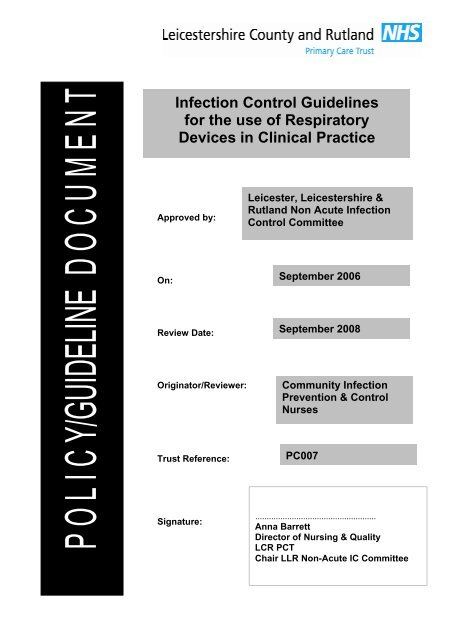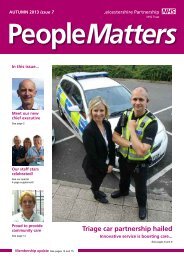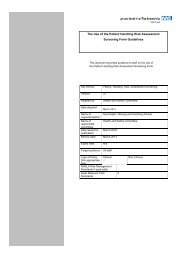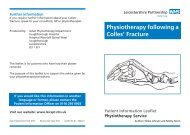Guidelines for the Use of Placebo Inhaler Devices, Peak Flow ...
Guidelines for the Use of Placebo Inhaler Devices, Peak Flow ...
Guidelines for the Use of Placebo Inhaler Devices, Peak Flow ...
Create successful ePaper yourself
Turn your PDF publications into a flip-book with our unique Google optimized e-Paper software.
Approved by:<br />
On:<br />
Infection Control <strong>Guidelines</strong><br />
<strong>for</strong> <strong>the</strong> use <strong>of</strong> Respiratory<br />
<strong>Devices</strong> in Clinical Practice<br />
Review Date:<br />
Originator/Reviewer:<br />
Trust Reference:<br />
Signature:<br />
Leicester, Leicestershire &<br />
Rutland Non Acute Infection<br />
Control Committee<br />
September 2006<br />
September 2008<br />
Community Infection<br />
Prevention & Control<br />
Nurses<br />
PC007<br />
.....................................................<br />
Anna Barrett<br />
Director <strong>of</strong> Nursing & Quality<br />
LCR PCT<br />
Chair LLR Non-Acute IC Committee
<strong>Guidelines</strong> <strong>for</strong> <strong>the</strong> use <strong>of</strong> Respiratory <strong>Devices</strong><br />
in Clinical Practice<br />
The potential risk <strong>of</strong> cross infection around <strong>the</strong> multi-patient use <strong>of</strong> placebo<br />
inhaler devices, spacer devices, peak flow meters, and inspiratory flow meters<br />
has recently been identified nationally and locally as an issue in both acute<br />
and primary healthcare settings. Current practice is variable and has <strong>the</strong><br />
potential <strong>for</strong> poor clinical practice and placing <strong>the</strong> patient at risk (Clancy<br />
2003).<br />
The British Thoracic Society (2005) has recently published practical<br />
recommendations relating to <strong>the</strong> cleaning and decontamination <strong>of</strong> <strong>the</strong>se<br />
devices and this has led to some confusion amongst clinicians.<br />
Medical devices identified by a manufacturer as ‘single use’ are intended to<br />
be used on an individual patient during a single procedure and <strong>the</strong>n<br />
discarded. It is not intended that <strong>the</strong>y be reprocessed and used on ano<strong>the</strong>r<br />
patient or <strong>the</strong> same patient on ano<strong>the</strong>r occasion.<br />
The following symbol is used on medical device packaging indicating “Do Not<br />
Reuse” and may replace any wording<br />
Manufacturers <strong>of</strong> medical devices have also identified some <strong>of</strong> <strong>the</strong>ir products<br />
as ‘single patient use’ and as such <strong>the</strong>y are not intended <strong>for</strong> repeated use by<br />
several different patients.<br />
<strong>Peak</strong> <strong>Flow</strong> Meters<br />
Disposable mouthpieces with one-way expiratory valves must always be<br />
used.<br />
Inspiratory <strong>Flow</strong> Meters<br />
Inspiratory flow meters can be used to check inspiratory flow and correct<br />
inhalation technique. Disposable mouthpieces with one-way inspiratory valves<br />
must always be used. Disposable mouthpieces with both inspiratory and<br />
expiratory valves can be purchased.<br />
Dry Powder <strong>Devices</strong><br />
Dry powder devices can be used <strong>for</strong> demonstration purposes only (to<br />
demonstrate to patients <strong>the</strong> correct procedure <strong>for</strong> loading and operating <strong>the</strong><br />
device).<br />
PC007 – Respiratory <strong>Devices</strong> in Clinical Practice <strong>Guidelines</strong><br />
Final – September 2006<br />
Review Date – September 2008<br />
Community Infection Prevention and Control Nurses<br />
2






